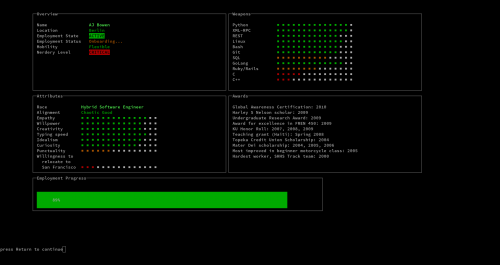I don’t think I’ve ever met a technical person, who didn’t exhibit at least some of the traits described in this article. And that includes myself as well. It’s usually not all that bad, but still …
Tag: geek culture
The coolest tech CV ever
This TravisCI blog post welcomes AJ to the team. In it, there is a bit that caught my attention (except, of course, the one about bra burning):
If you’re so inclined, you can follow her on Twitter or run curl cv.soulshake.net.
Wait a second … A what? curl for the CV? I had to try it out. Here’s an even better way, for reading all the slides:
p=1; while [ $p -lt 9 ]; do curl -N cv.soulshake.net/$((p++)); read; done
Oh. My. God. Lo and behold, this is the coolest tech CV I’ve ever seen. Ever. Period. TravisCI is so lucky to have her!
P.S.: If you are interested in how this was done, here a couple of blog posts – one and two.
Things Every Hacker Once Knew
Eric Raymond goes over a few things every hacker once knew.
One fine day in January 2017 I was reminded of something I had half-noticed a few times over the previous decade. That is, younger hackers don’t know the bit structure of ASCII and the meaning of the odder control characters in it.
This is knowledge every fledgling hacker used to absorb through their pores. It’s nobody’s fault this changed; the obsolescence of hardware terminals and the near-obsolescence of the RS-232 protocol is what did it. Tools generate culture; sometimes, when a tool becomes obsolete, a bit of cultural commonality quietly evaporates. It can be difficult to notice that this has happened.
This document is a collection of facts about ASCII and related technologies, notably hardware terminals and RS-232 and modems. This is lore that was at one time near-universal and is no longer. It’s not likely to be directly useful today – until you trip over some piece of still-functioning technology where it’s relevant (like a GPS puck), or it makes sense of some old-fart war story. Even so, it’s good to know anyway, for cultural-literacy reasons.
The article goes over:
- Hardware context
- The strange afterlife of the outboard modem
- 36-bit machines and the persistence of octal
- RS232 and its discontents
- UUCP, the forgotten pre-Internet
- Terminal confusion
- ASCII
- Key dates
Found via a couple of other interesting bits –
What we still use ASCII CR for today (on Unix) and
How Unix erases things when you type a backspace while entering text.
Drupal and Playboy
https://twitter.com/vmbrasseur/status/804739968950104064
Slashdot has the details for the story, if you haven’t heard it yet. Inappropriate? Maybe. But then again, where do you draw the line of what’s inappropriate in the sponsor’s bag? (Beer and other alcoholic beverages are very welcome, for example.)
I tend to take things on the lighter side, considering it to be somewhat entertaining and mildly funny.
ASCII vs. ANSI
Browserling does it again:
For those of you not old enough, here are the ASCII and ANSI Wikipedia pages. Back in a day we used these for cool art, fancy user interfaces, email signatures, games and more. Have a look at some cool examples of ASCII art. Now imagine those “images” colored with the breathtaking variety of 8 colors and you’ve got yourself a true 90’s rainbow explosion.
You’d probably be surprised to learn that a lot of these have survived to modern day, and are still used in command line user interfaces.
P.S.: And if you think that this stuff is ancient, have a look at typewriter art example.


